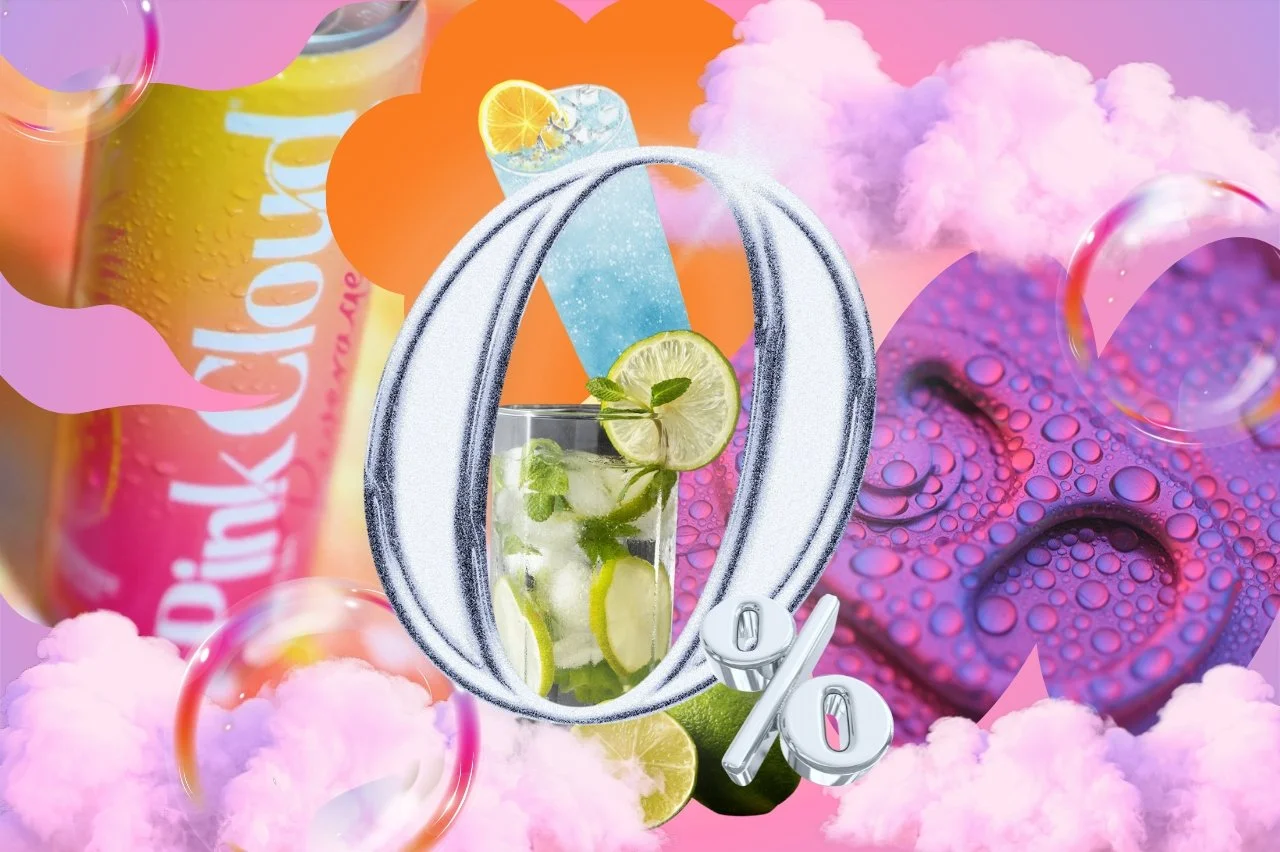The Rise of Zero-Proof Beverages
Non-alcohol concepts are currently trending. Mocktail recipes are constantly cluttering social media feeds. “Sober-curious” is a popular hashtag for those pursuing a life without spirits.
In photo: Pink Cloud Beverages
“...only 42% of millennials actually drink. For Gen Z, the total is halved, with only 21% imbibing on a regular basis.”
In 2023, demand for zero-proof beverages is at an all-time high. Both millennials and Gen Z have an all-or-nothing approach, considering alcohol-free beverages on their own terms.
To some, this means mixing zero-proof spirits. For others, they utilize non-alcohol ingredients to create alcohol-free cocktails. In previous generations, fun was an intoxicated-fueled life. Now, with increased health awareness, consumers are creating their own style for imbibing. In total, only 42% of millennials actually drink. For Gen Z, the total is halved, with only 21% imbibing on a regular basis.
A Specialty Market
“55% of the most influential bartenders in London, LA, and NYC believe the no-alcohol ABV trend will grow in the next 12 months. Over 40% of restaurants in LA now offer non-alcoholic specific drink menus.”
To many, non-alcohol spirits to dairy- and meat-alternative sectors of the food industry. Originally, these specialty markers were slow to gain traction, but are now prevalent in every grocery store throughout the country.
Zero-proof beverages continue to gain traction at a variety of retail stores — both brick-and-mortar and online. Retailers are gradually providing clear signage for their zero-proof offerings in different sections, effectively increasing the square footage of non-alcohol displays to accommodate new brands. Most on-premise believe that products are better suited to mixing in cocktails instead of sipping directly. Still, zero-proof sipping spirits are expected to be a new offshoot of the category.
Bars and restaurants are also jumping on the trend, offering menus with the addition of zero-proof drinks. According to Distill Ventures, 55% of the most influential bartenders in London, LA, and NYC believe the no-alcohol ABV trend will grow in the next 12 months. Over 40% of restaurants in LA now offer non-alcoholic specific drink menus.
“82% of people who drink non-alcoholic drinks also drink alcohol...”
Just because consumers drink zero-proof beverages, they also enjoy a cocktail too. In fact, 82% of people who drink non-alcoholic drinks also drink alcohol but still do it in moderation, aware of the negative effects overindulging has on health.
Growth
“Last year, sales of zero-proof beverages increased by 90%, totaling $11 billion.”
This is up from $8 billion in 2018, as per IWSR Drinks Market Analysis. Zero-proof beverages grew by more than 7% in volume across ten key global markets, with a CAGR of 7%. In particular, e-commerce offerings increased by 24%, with zero-proof labels increasing by 70% on websites.
Offerings are expected to grow in the United States by 25.6% by 2026.
In contrast, last year saw alcoholic spirit sales slip about 1% to just under $21 billion.
Legality
In numerous states — including Georgia, Tennessee, Texas, Illinois, and Kansas — direct-to-consumer shipping of nonalcoholic beer is still illegal. These outdated laws go back to Prohibition; currently, beer distributors are lobbying to monopolize non-alcoholic sales. Still, you must be over 21 years old in most states to purchase. However, once a non-alcoholic product is made, legally, it’s considered a soda or another beverage. It’s no longer categorized as an alcoholic product. This is especially true in tax treatment. Currently, the Alcohol and Tobacco Tax and Trade Bureau doesn’t include federal alcohol excise taxes on zero-proof beverages. With this in mind, it’s strange that non-alcoholic offerings have similar restrictions.
Technology
Believe it or not, there are actually machines available for sale or rent that remove alcohol from beer to craft breweries. The machines are also available at distilleries and wineries. Plus, once the machine removes alcohol from the beer, it can be repurposed for hard seltzers. In many ways, more and more brewers are jumping to the zero-proof industry, realizing that they have the option to turn their offerings into two products: non-alcoholic beer and trendy hard seltzer.
In order to create a non-alcoholic beverage, the ABV must be measured to meet regulatory requirements, optimize recipe creation, and minimize any liability.
Criticisms
Zero-proof isn’t cheap. Bottles of non-alcoholic spirits are priced in the $20 to $30 range on Amazon. Those skeptical are money-conscious prospects who dismiss the high prices as gouging. These consumers must be convinced that the quality is there.
Furthermore, there is confusion among consumers with respect to the labeling of low-and no-alcohol products. Offerings are defined by colorful cans and festive packages that draw the eye, blending in with other alcoholic options, resulting in accidental purchases.
In addition, any potential health benefits resulting from the production and replacement consumption of zero-proof beverages is superfluous. There is a lack of health-oriented reviews to examine the evidence base of the reduction in the harmful ethanol content of alcoholic beverages. There is also relatively small and incoherent scientific literature on consumption, production, and the potential health impact of zero-proof. The evidence base is considered insufficient.
The Future
© Martini & Rossi®
Along with new entrants, established alcohol brands are also jumping on the non-alcohol bandwagon. For example, Martini & Rossi, a Bacardi company, has launched alcohol-free Floreal and Vibrante. Other major alcohol companies include Heineken, AB InBev, and Molson Coors.
Those who are pregnant and people enduring gastric disorders can also partake in social drinking options without the stigma associated with being unable to consume alcohol.
De-alcoholized wine is slowly becoming a varietal. The dealcoholization process changes the flavor of wine; therefore, the best-tasting non-alcoholic wines blend two or more grapes that are blended to taste after dealcoholization. This can be tricky, with the wine industry facing increased oil wine ABV due to climate change conditions. Still, this dealcoholization has to overcome the loss of desirable sensory properties appreciated by consumers.
Food and beverage brands can capitalize on the recent mocktail trend in a variety of different ways. Food brands can promote pairings with mocktails or non-alcoholic beverages. Beverage brands can make a name for themselves as the functional ingredients in these non-alcoholic concoctions. For example, adaptogens or CBD can be used as ingredient replacements, showing off their versatility cross-platform.
We know how to craft a solid mocktail. If you’d like us to serve you one, let’s talk here.


